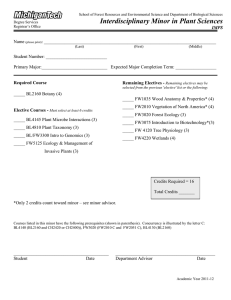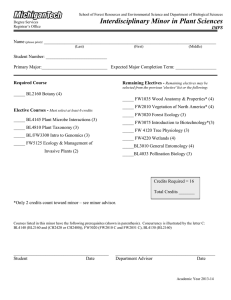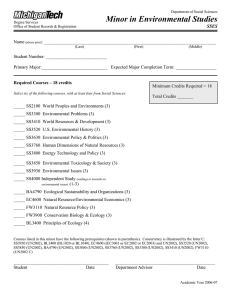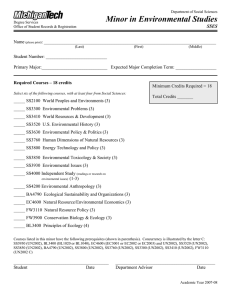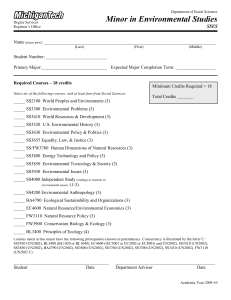The University Senate of Michigan Technological University Proposal 44-15
advertisement
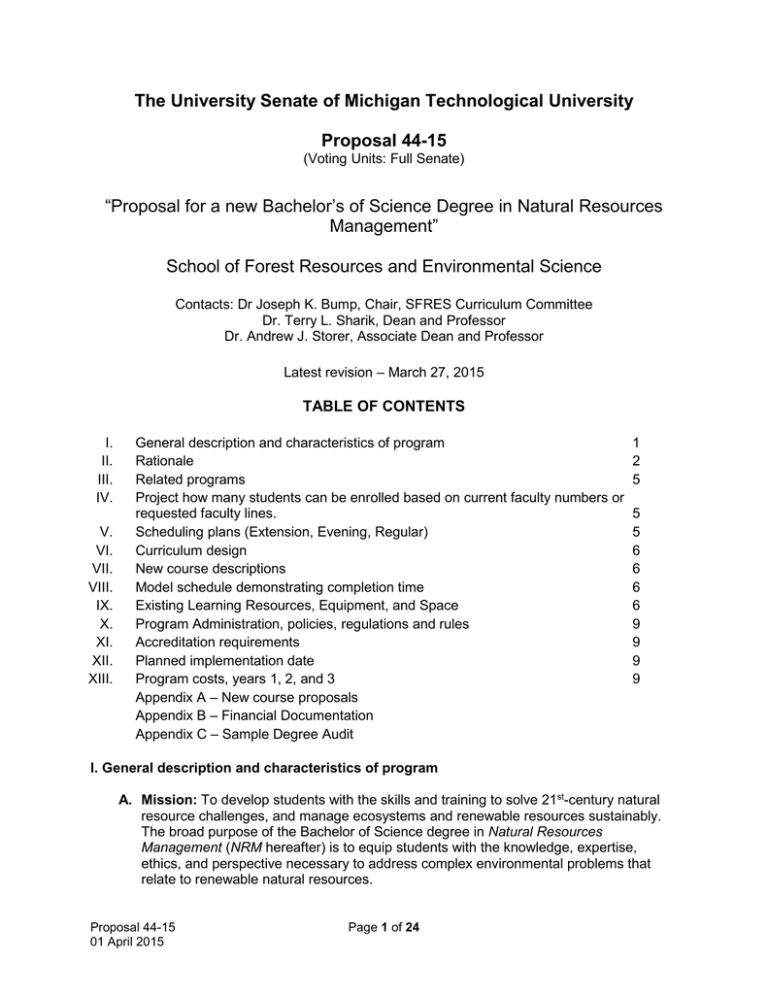
The University Senate of Michigan Technological University Proposal 44-15 (Voting Units: Full Senate) “Proposal for a new Bachelor’s of Science Degree in Natural Resources Management” School of Forest Resources and Environmental Science Contacts: Dr Joseph K. Bump, Chair, SFRES Curriculum Committee Dr. Terry L. Sharik, Dean and Professor Dr. Andrew J. Storer, Associate Dean and Professor Latest revision – March 27, 2015 TABLE OF CONTENTS I. II. III. IV. V. VI. VII. VIII. IX. X. XI. XII. XIII. General description and characteristics of program Rationale Related programs Project how many students can be enrolled based on current faculty numbers or requested faculty lines. Scheduling plans (Extension, Evening, Regular) Curriculum design New course descriptions Model schedule demonstrating completion time Existing Learning Resources, Equipment, and Space Program Administration, policies, regulations and rules Accreditation requirements Planned implementation date Program costs, years 1, 2, and 3 Appendix A – New course proposals Appendix B – Financial Documentation Appendix C – Sample Degree Audit 1 2 5 5 5 6 6 6 6 9 9 9 9 I. General description and characteristics of program A. Mission: To develop students with the skills and training to solve 21st-century natural resource challenges, and manage ecosystems and renewable resources sustainably. The broad purpose of the Bachelor of Science degree in Natural Resources Management (NRM hereafter) is to equip students with the knowledge, expertise, ethics, and perspective necessary to address complex environmental problems that relate to renewable natural resources. Proposal 44-15 01 April 2015 Page 1 of 24 B. Goals: Environmental problems are fundamentally natural resource and ecosystem management problems. Finding solutions and providing leadership on environmental issues requires a broad based foundation in natural resources science and ecosystem management. The School of Forest Resources and Environmental Science (SFRES) at Michigan Technological University (Michigan Tech) has broad expertise and offers three specialized degrees in natural resource fields (Forestry, Wildlife Ecology and Management, and Applied Ecology and Environmental Sciences). The goal of this new major is to provide broad-based training and comprehensive understanding of the interdependence of ecological and sociopolitical systems in the context of natural resource and ecosystem management. C. Objectives: This proposal will implement an undergraduate Bachelor of Science degree program in NRM that 1) attracts students with diverse interests in environmental issues, natural resource science, sustainability, biomaterials, and ecosystem management; 2) provides a broad-based curriculum that will allow students to gain the knowledge and develop the skills necessary to design solutions for 21st-century environmental problems; 3) receives accreditation from Society of American Foresters as a Natural Resource and Ecosystem Management undergraduate degree program. II. Rationale A. National trends in natural resources: Nationally, enrollment in Bachelor of Science majors in the area of natural resources and environmental or ecosystem management are eclipsing more specialized programs (Figures 1 & 2). For example, the Society of American Foresters, which accredits our School’s Forestry degree, developed accreditation standards for NRM majors for the first time in 2014. The proposed program aims to capitalize on this trend and anticipate future student interests and occupational trends. The job market for NRM is broader than our more specialized programs and this degree program provides a sound undergraduate education for students who wish to enter other areas of the job market or graduate school. Figure 1. Undergraduate enrollment in Natural Resources by field of study for institutions in the National Association of University Forest Resource Programs (NAUFRP), 1980-2009. Proposal 44-15 01 April 2015 Page 2 of 24 Figure 2. Proportion of undergraduate enrollment in Natural Resources in the National Association of University Forest Resource Programs (NAUFRP) in 2010. B. Students: An increase in the number of students coming to Michigan Tech is expected with the implementation of this program, as it will appeal to a broader range of interests in natural resources and environmental science. Presently, the School of Forest Resources and Environmental Science has ~150 undergraduate students, divided among the Forestry, Wildlife Ecology & Management, and Applied Ecology & Environmental Sciences majors. Michigan Tech has a reputation, fostered by students and alumni alike, for having high standards for graduation. The quality of the School's incoming freshman compares very well with the at-large average for Michigan Tech. Students entering Michigan Tech average 27.0 on the ACT; those entering the School of Forest Resources and Environmental Science average 27.1. This standard will be maintained or enhanced with the addition of this degree program. Approximately one third of the School of Forest Resources and Environmental Science undergraduates enter as transfer students. These students include internal transfers as well as students who transfer from community colleges and other programs outside Michigan Tech. We anticipate that the NRM major will attract transfer students from outside Michigan Tech as well as freshman students. This program will strengthen the bond between Michigan Tech and community colleges in the Upper Great Lakes Region. The School of Forest Resources and Environmental Science offers financial aid to students which totals around 65K annually. In addition, many students have the opportunity to gain work experience working in faculty labs and on field-based projects supported by external grants and contracts. C. Regional need: This program will uniquely satisfy a strong regional need. This need reflects the resource-based economy of the region. The universities in the Upper Great Lakes region lack a NRM program comparable to that proposed here. The program will Proposal 44-15 01 April 2015 Page 3 of 24 provide students with a broad educational experience, emphasize the development of skills and knowledge in natural resource science, but also address the sociological, political, and economic facets of natural resources and ecosystem management. This broad-based, multidisciplinary preparation will provide students with a background for employment potential in the diverse field of natural resources management. This field is anticipated to increase in the future due to high levels of interest in sustainable resource management, a growing biomaterials economy, and threats to resources posed by development, exotic species and global change. D. Diversity: The Native American community is one of the target audiences, and recent trends in Native American enrollment in NRM degree programs demonstrate strong potential for development (Figure 3). In addition, recruitment of students that do not belong to any specific target audience is projected to be very successful. The Lake Superior basin, with its important natural and economic resources, including state and national parks, is an ideal training ground for natural resources managers. E. Career flexibility: A Bachelor of Science Degree in NRM will prepare students for a wide variety of career options. Students may find employment as resource managers in the private sector, state and federal agencies, and non-governmental organizations. The NRM program will prepare students who want to develop more specialized skills at the graduate level through research or coursework based degrees. Other students will pursue this degree program due to their interests, and use it as a more broadly defined qualification as they enter the job market or graduate, law or business school. Figure 3. Associate and Baccalaureate degrees awarded in natural resource fields at tribal institutions in 2002-2010. 32 institutions reporting, FAEIS 2011. Proposal 44-15 01 April 2015 Page 4 of 24 F. University and School mission: The proposed program is consistent with the mission of Michigan Tech, especially in the areas of engagement to advance sustainable economic prosperity, ethical conduct and responsible use of resources. The proposed program addresses goal 2 in the strategic plan “A distinctive and rigorous action-based learning experience grounded in science, engineering, technology, sustainability, business, and an understanding of the social and cultural contexts of our contemporary world”. It also contributes to Goal 1.2 as we work to increase diversity through this type of program offering. The mission of SFRES is to foster excellence in forestry and ecological science. The proposed program in NRM will contribute to this mission by training undergraduates to be environmentally responsible Natural Resource Management professionals in a broad and growing field. III. Related Programs A. Within the School of Forest Resources and Environmental Science: The current majors in Forestry, Wildlife Ecology and Management, and Applied Ecology and Environmental Sciences within SFRES offer students more specialized approaches to focused areas in natural resources. The new NRM major will focus on the broad spectrum of technical and vocational aspects of natural resources and ecosystem management that are common across natural resource fields and environmental management occupations. Interest in NRM is both long-standing and widespread, and is growing throughout the Upper Great Lakes Region and across the country. B. Supporting Programs at Michigan Tech Many academic units at Michigan Tech offer coursework relevant to students pursuing the B.S. in NRM. The following academic units provide required or elective classes for students pursuing this degree, and have each been consulted in relation to the curriculum design: Departments of Biological Sciences, Social Sciences, Humanities, Mathematical Sciences, Geological Engineering and Sciences, and the School of Business and Economics. C. At other institutions: There is no other Bachelor of Science program in NRM in the Upper Peninsula, although, in other states, many forestry programs or school's of natural resources offer similar programs that are very successful. Only one other institution nationally, SUNY ESF, has an accredited B.S. in natural resources and environmental management. The School of Natural Resources and Environment at The University of Michigan has a Resource Ecology Program at the graduate level and Michigan State University offers undergraduate degrees in Fisheries and Wildlife Management, and Environmental Studies and Applications. Hence, a NRM degree program at Michigan Tech is expected to offer a unique experience to high school students interested in careers that focus on environmental science and natural resource fields. IV. Project how many students can be enrolled based on current faculty numbers or requested faculty lines. We project an annual enrollment of 10-20 new students per year in this program with existing faculty numbers. V. Scheduling plans (Extension, Evening, Regular). Regular. VI. Curriculum Design Proposal 44-15 01 April 2015 Page 5 of 24 To obtain a B.S. degree in NRM, students will be required to take a minimum of 69 credits in courses fundamental to natural resources management (offered by the School of Forestry and Environmental Science, Department of Biological Sciences, and Department of Mathematics), of which 9 credits are natural resource electives. In addition, 8 credits of social dimensions (5 required and 3 from an elective list), and 9 credits of economics, business, management, or marketing electives are required (Table 1). SFRES faculty voted unanimously in support of this curriculum design. This program would be distinct from our other programs in that: • It has a social/human dimensions sequence of 8 credits (5 credits more than our existing majors), with a minimum of 6 of these credits taught by faculty with primary appointments in the Department of Social Sciences. • It has an economics/business sequence of 9 credits, with all 9 credits taught by faculty with primary appointments in the School of Business and Economics. • It has a unique capstone class (3 credits); Biogeochemistry (3 credits), Natural Resources Ethics & the Environment (2 credits), and Natural Resource Conservation seminar (2 credits) required. VII. New course descriptions. Two new courses are needed for this program, Biogeochemistry and Capstone Experience for in Natural Resources Management (New Course Add Forms are in Appendix B). These courses will be taught by existing faculty members as part of their regular teaching load. VIII. Model schedule demonstrating completion time. Please see Figure 4. IX. Existing Resources, Equipment, and Space A. Faculty. All of the faculty in the School of Forest Resources and Environmental Science hold the Ph.D. degree, and many are considered national and international experts. They share a commitment to quality teaching and to providing an excellent learning environment. Active in their professions, the faculty share their expertise and keep current through research and by participating in conferences, presenting seminars, and publishing in professional journals: There are ~35 research and tenure-track faculty and administrators in the School who contribute to our undergraduate teaching mission. Full curricula vitae are available at http://www.mtu.edu/forest/about/faculty-staff/ B. Physical Facilities: The School of Forest Resources & Environmental Science occupies space in a number of buildings located on the campus of Michigan Technological University and in the surrounding local area. These include the UJ Noblet Forest Resource and Environmental Science building, the Ford Center and Forest, and the Isle Royale Sands Research facility. This space is adequate to meet the needs of this program. C. Library Resources: The proposed degree is based on courses currently offered for Applied Ecology and Environmental Sciences, Wildlife Ecology and Management, Forestry, and Biological Sciences majors. The basic library resources are already in place supporting these programs, including journals, electronic databases, government documents and access to interlibrary loan services Proposal 44-15 01 April 2015 Page 6 of 24 As the program matures, specific deficiencies in the Library holdings may become apparent. A reevaluation of library resources, with the potential of adding new resources should be included in the program assessment when it reaches its enrollment capacity. Table 1: Curriculum design for proposed B.S. in Natural Resources Management Major Requirements Course Title FW2010 Vegetation of North America FW2051 Field Techniques FW1050 The Natural Resources Professional EC2001 Principles of Economics FW2030 Natural Resources Conservation FW3330 Soil Science FW3020 Forest Ecology FW3200 Biometrics & Data Analysis FW3540 Introduction to GIS for Natural Resource Management FW3110 Natural Resource Policy FW3012 Survey of Silviculture FW3170 Land Measurements/GPS FW3190 Multi-resources Assessment FW3180 Geomorphology, Landscapes, & Ecosystems FW3600 Wildlife Habitat FW3640 Aquatic Systems FW3840 Forest Health Introduction to Outdoor Recreation and Tourism FW3510 Systems FW4710 Environmental Biogeochemistry FW4380 Landscape Ecology and Planning FW3115 Natural Resources, Ethics, and the Environment FW4150 Forest Resource Management FW4830 Natural Resources Assessment and Planning Directed Electives (Social Dimensions 3, Business related 6, Communications 3, Natural Resource 9) Gen Ed Core Gen Ed LG-HASS Gen Ed STEM Free Electives Total Credits 4 2 2 3 2 4 3 4 4 3 2 1 3 2 3 2 3 3 3 3 2 3 3 21 12 12 16 3 128 A total of 128 credits will be needed to graduate in this degree program with students receiving a Bachelor of Science in four years (Figure 4 – course sequence). Proposal 44-15 01 April 2015 Page 7 of 24 Figure 4. Course Sequence for B.S. in Natural Resources Management Proposal 44-15 01 April 2015 Page 8 of 24 D. Computer Facilities The existing computer facilities are adequate to support this program. This includes computer teaching labs in SFRES and around campus, software and network access. GIS and Remote Sensing software utilized for teaching includes: ERDAS, Arc/Info, and ArcView. The major portion of undergraduate instruction in geographic information systems is conducted in a computer teaching laboratory that exists for this purpose. X. Program Administration, Policies, Regulations and Rules. Responsibility for administration of the program will reside with the Dean of the School of Forest Resources and Environmental Science, who reports to the Executive VicePresident and Provost for Academic Affairs. XI. Accreditation requirements. A goal in developing this new degree is to meet The Society of American Foresters accreditation standards for NRM programs. The proposal and specifically the curriculum were developed with these standards in mind. These requirements are available at http://www.safnet.org/education/AccHdbk_Dec2014.pdf XII. Planned implementation date. Fall 2015 XIV. Program costs, years 1, 2, and 3. No new resources are requested at this time. Classes to be offered under this proposal are either already offered and can accommodate the students in this program, or are being proposed as part of regular faculty workloads. Please see Appendix B, Financial Documentation. Approvals: Faculty of SFRES – Feb 10, 2015 (unanimous) Provost’s Office University Senate Provost and University President Board of Control Proposal 44-15 01 April 2015 Page 9 of 24 Proposal 44-15 01 April 2015 Page 10 of 24 Proposal 44-15 01 April 2015 Page 11 of 24 Proposal 44-15 01 April 2015 Page 12 of 24 Proposal 44-15 01 April 2015 Page 13 of 24 Proposal 44-15 01 April 2015 Page 14 of 24 Proposal 44-15 01 April 2015 Page 15 of 24 Proposal 44-15 01 April 2015 Page 16 of 24 Proposal 44-15 01 April 2015 Page 17 of 24 Proposal 44-15 01 April 2015 Page 18 of 24 Proposal 44-15 01 April 2015 Page 19 of 24 Appendix B: Financial documentation I. Relation to University Strategic Plan a. Relation of program to the university's educational and research goals. The proposed major fits with goal 2 of the strategic plan. “GOAL 2: A distinctive and rigorous action-based learning experience grounded in science, engineering, technology, sustainability, business, and an understanding of the social and cultural contexts of our contemporary world.” Specifically, the proposed major integrates science, sustainability, business and the social and cultural contexts of natural resources and natural resource management. b. Consistency with the university's resource allocation criteria. No new resources are being requested at this time II. Impact on University Enrollment a. Projected number of students in the program. We project an annual enrollment of 10-20 new students per year in this program. b. Source of new students; in particular, will the students be drawn from existing programs, or will they be students who would otherwise not have come to Michigan Tech? It is possible that some students may come from other majors within the School of Forest Resources and Environmental Science (SFRES), but we project that most enrollment will be of students who are looking for a more broadly based degree program than those currently offered. c. What is the likely correlation between demand for the new program and existing enrollment patterns at Michigan Tech? We project that enrollment in SFRES will increase while undergraduate enrollments in many other units is projected to remain in a steady state. d. What is the current enrollment in the unit? 155 undergraduates, 75 graduate students III. Impact on Resources Required by Department in Which the Program is housed. This would include, but not be limited to: a. Faculty lines. No new faculty lines are requested. b. Faculty and student labs, including ongoing maintenance. Adequate classroom and laboratory space is available. The school has recently remodeled a classroom to house over 60 students, which replaces a classroom that housed 32 students. c. Advising. Proposal 44-15 01 April 2015 Page 20 of 24 The current arrangements for advising will be adequate. d. Assessment. This program will be assessed as part of the ongoing University assessment program. All of the University learning goals will be addressed by one or more classes in the proposed program. Courses that are outside of the general education requirements will address disciplinary knowledge as well as other university learning goals. IV. Impact on Resources Required By other Units Within the University. This analysis would include, but not necessarily be limited to, the impacts on: a. Other academic (e.g., Gen Ed) units with regard to faculty, labs and assessment. (NOTE: The current Student to Faculty ratio for the university as a whole is approximately 12:1 per Institutional Analysis.) Classes in other academic units have been reviewed by those units, and the capacity is available to serve the students in the new major. b. Information Technology, the Library, central administration and career planning with respect to the impact on the need for computing services, library resources, advising, record keeping, development of employer relations etc. Existing resources are sufficient to support the new major. V. Assessment of the ability to obtain the necessary resources assuming requested funds are obtained a. For high demand fields (e.g., business fields, etc.), will it be possible to fill allocated lines. No lines are requested at the initiation of this degree program VI. Past proposals. Has the department initiated any other new degree programs in the last five years? If so: No undergraduate degree programs have been proposed in the last 5 years. A Master’s of Geographic Information Science was recently approved and is now offered. a. Describe the extent to which the new program has met the original goals with respect to: 1. Enrollment, Enrollment in the new MGIS degree program is low as advertising outside of Michigan Tech has been limited. Students are starting to register for he accelerated version of the degree as they near completion of their undergraduate degree programs. Enrollment in the classes that have been added to the new MGIS have been good – their subject area appeals to a range of graduate students, and they have enhanced the graduate student experience for many. 2. Costs, To date, the MGIS has met its goals in terms of costs. 3. New faculty, A lecturer is supported under the new MGIS program. 4. Other resources required for the program b. How have degree programs added in the past five years affected total Proposal 44-15 01 April 2015 Page 21 of 24 enrollment in the department? The MGIS is too new to have significantly impacted overall enrollment. VII. Departmental Budget contribution a. What is the department's total general fund budget? 2013-2014 $3,658,751 b. How much tuition does the department generate? This information should be provided for both the credit hours taught by the department and the number of credit hours taken by the department's majors. 2013-14 SCH data from compendium – all instructional activity LOWER 520.0 UPPER 2,829.0 MASTER 644.0 DOCTOR 321.5 TOTAL 4,314.5 If all students are in state, based on 2014-15 tuition rates, undergraduate revenue = 467*(520+2829) = $1,563,983. Graduate revenue = 820.50*(644+321.5) = $792,192 2013-14 SCH data from compendium – tenure/tenure track instructional activity UNDERGRADUATE 2,402.0 MASTER 521.8 DOCTOR 290.0 TOTAL 3,213.8 For SFRES students taking 32 credits a year (undergraduate) and 19 credits a year (graduate), based on 2014-15 enrollment, total tuition revenue = 155*467*32 (undergraduate) plus 75*820.50*19 (graduate) = $3,485,532. VIII. How do the benefits from this program compare to other alternatives that are currently under consideration or development. Will approval and allocation of resources to this program preclude the development of other programs? A major in Natural Resource Management is the top priority for a new undergraduate degree program within the School. Natural Resource degree programs have been performing very well at the national level. Proposal 44-15 01 April 2015 Page 22 of 24 Appendix C BS in Natural Resources Management: sample degree audit Major Requirements Course FW2010 FW2051 FW1050 EC2001 FW2030 FW3330 FW3020 FW3200 FW3540 FW3110 FW3012 FW3170 FW3190 FW3180 FW3600 FW3640 FW3840 FW3510 FW4710 FW4380 FW3115 FW4150 FW4830 One of SS3315 SS3410 SS3313 SS3520 SS3521 SS3630 SS3635 SS/FW3760 SS3800 SS4010 SS4200 Credits 4 2 2 3 2 4 3 4 4 3 2 1 3 2 3 2 3 3 3 3 2 3 3 3 Course Two of EC3400 ED4500 EC4650 EC4640 ACC2000 BUS2300 MGT3000 MKT3000 One of HU2645 HU3120 HU3606 HU3630 HU3871 HU4625 HU4628 HU4693 ED4850 9 credits from (credits) FW1035 (4) FW3320 (3) FW3410 (3) FW3610 (4) FW4120 (3) FW4140 (3) FW4220 (4) FW4240 (4) FW4300 (3) FW4370 (3) FW4540 (3) FW4541 (1) FW4545 (2) FW4610 (3) FW4620 (3) FW5115 (3) BL4442/BL4447 (4) BL2160 (4) BL2170 (4) GE2100 (3) GE4150 (3) STEM requirement (16 credits) BL1040 MA1032 Or MA1135 CH1150 and CH1151 MA2720 Proposal 44-15 01 April 2015 4 4 4 4 Page 23 of 24 Credits 3 3 3 9 Free Electives 3 General education requirements (Credits 24) Course number UN1015 3 UN1025 3 HUFA 3 FA2330, 2520, 2720, 2820, HU2130, 2501, 2538, 2700, 2720,2820, 2910 SBS 3 EC2001, PSY2000, SS2100, 2200, 2400, 2500, 2501, 2502, 2503, 2504, 2505, 2600, 2700 HASS Distribution Course: 12 total credits required No more than 3 credits from the HASS Creative Endeavors List Six (6) credits must be at the 3000 or 4000 level No more than 3 credits from the HASS Supplemental List 3 3 3 3 *A 3000-level or higher modern language course may be used in place of UN1025, Global Issues. TOTAL Proposal 44-15 01 April 2015 128 Page 24 of 24
